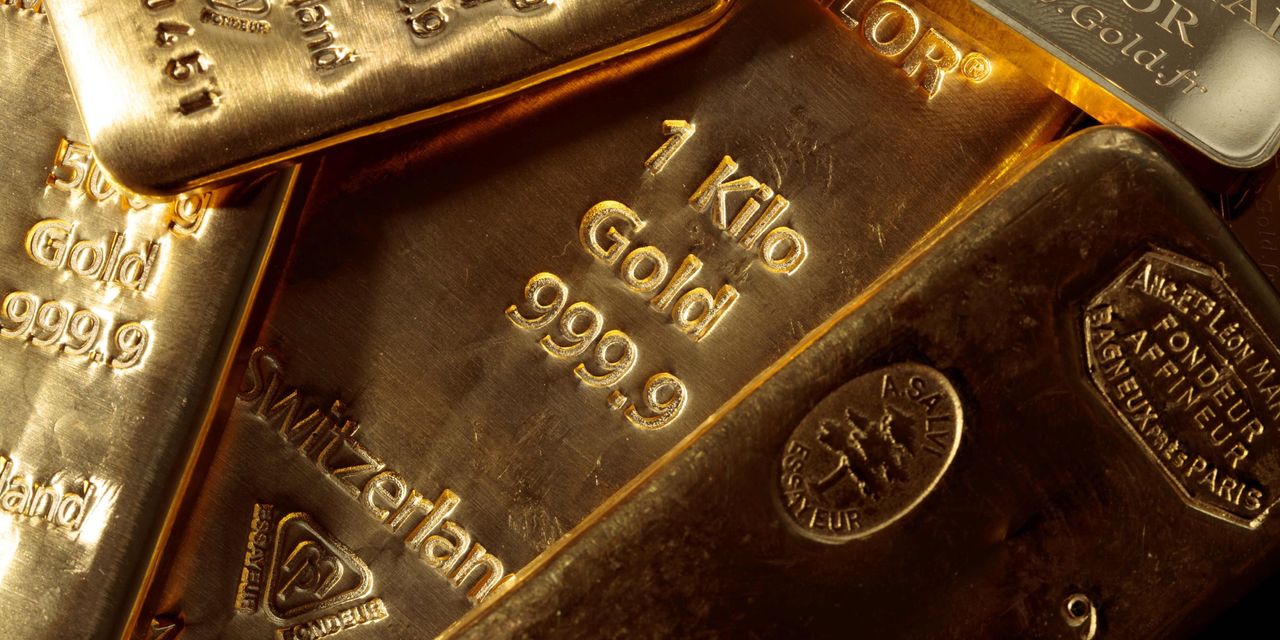Gold futures recovered from early losses Thursday to finish higher, with prices rebounding from their first intraday drop below $1,950 an ounce this month.
The price moves follow the Federal Reserve’s decision on Wednesday afternoon to leave its key benchmark interest rate steady, though the central bank also indicated that its rate-hiking cycle isn’t over.
Price action
-
Gold for August delivery
GC00,
-0.13% GCQ23,
-0.13%
rose $1.80, or about 0.1%, to settle $1,970.70 per ounce on Comex after trading as low as $1,936.10, FactSet data show. Prices for the most-active contract hadn’t traded at a level that low since late May. -
Silver for July
SI00,
+0.72% SIN23,
+0.72%
delivery declined by 16 cents, or 0.7%, to $23.95 per ounce. -
Palladium for September
PAU23,
+1.45%
delivery declined by $4.90, or nearly 0.4%, to $1,397.30 per ounce, while platinum for July
PLN23,
-0.53%
delivery climbed by $11.90, or 1.2%, to $991.90 per ounce. -
Copper for July
HGN23,
-0.40%
delivery fell by 3 cents, or 0.8%, to $3.90 per pound.
What’s happening
Federal Reserve Chairman Jerome Powell and his colleagues on the Fed’s policy-setting committee on Wednesday signaled that the central bank would likely keep hiking interest rates later this year, even though it refrained from doing so at its latest meeting.
That did “not support the view that the Fed might pivot and begin cutting rates before the end of 2023,” said George Milling-Stanley, chief gold strategist at State Street Global Advisors, in comments after Wednesday’s Fed announcement. This month’s pause in rate hikes is “intended to allow the Fed to determine more precisely just how successful it is being in reducing inflation, and how much additional policy tightening may be required.”
Higher interest rates typically boost the U.S. dollar, making gold more expensive to foreign buyers, while increasing the yield that investors can reap from holding Treasury bonds.
In Thursday dealings, however, the ICE U.S. Dollar Index
DXY,
a gauge of the dollar’s strength against major currencies, was down 0.8% to 102.16, providing some support for dollar-denominated prices of gold.
A similarly hawkish outlook from the European Central Bank helped to keep a lid on gains, said Michael Hewson, chief market analyst at CMC Markets UK, in a market update.
The ECB lifted interest rates by a quarter of a percentage point, as expected. In its statement, the central bank said that while inflation has been coming down, it is “projected to remain too high for too long.”
Meanwhile, the “contradictory message coming out of [Wednesday’s] Fed announcement, a hawkish pause, highlighted the difficulty the U.S. central bank still faces in bringing inflation back down to its 2% target without tipping the country into recession,” said Rupert Rowling, market analyst at Kinesis Money, in emailed commentary.
“Recent positive data on both the inflation and jobs front suggest the world’s largest economy is holding up well, and this is likely to increase risk appetite among investors to the detriment of gold and its safe haven qualities,” he said.
Data released Thursday showed that sales at U.S. retailers rose 0.3% in May. Sales had been forecast to drop 0.2%, based on a Wall Street Journal poll of economists. Separately, U.S. industrial production fell 0.2% in May after two straight months of gains, while the number of Americans who applied for unemployment benefits last week was unchanged at 262,000.
Read the full article here











